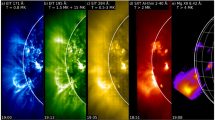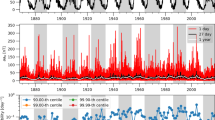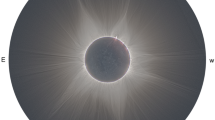Abstract
Forbush decreases occurring from 1997 to 2017 (1055 events in total) have been analyzed with the use of a database of Forbush effects and interplanetary disturbances built and currently maintained by the Pushkov Institute of Terrestrial Magnetism, Ionosphere, and Radio Wave Propagation of the Russian Academy of Sciences (IZMIRAN). Based on statistical methods, we compared the temporal evolution of Forbush decreases in events of four types: (1) those associated with coronal mass ejections from active regions and accompanied by solar flares; (2) those induced by interplanetary disturbances due to filament eruptions from areas beyond active regions; (3) those caused by high-speed streams from coronal holes; and (4) those associated with two or more sources of different types of disturbances. In the comparison, we used the following time parameters of the development of Forbush decreases: the time intervals from the event onset to the detection of the minimal density of cosmic rays, the maximal hourly decrease in the density of cosmic rays, the maximal equatorial anisotropy of cosmic rays, the maximal speed of the solar wind, the maximal strength of the interplanetary magnetic field, and the minimal Dst index. Analysis of the distributions of the time parameters and their intercorrelation has shown that there are substantial differences between the evolution scenarios of Forbush decreases in the four sets of examined events.








Similar content being viewed by others
REFERENCES
Abunin, A.A., Abunina, M.A., Belov, A.V., Eroshenko, E.A., Oleneva, V.A., and Yanke, V.G., Forbush effects with a sudden and gradual onset, Geomagn. Aeron. (Engl. Transl.), 2012, vol. 52, no. 3, pp. 292–299.
Abunina, M.A., Abunin, A.A., Belov, A.V., Eroshenko, E.A., Asipenka, A.C., Oleneva, V.A., and Yanke, V.G., Relationship between Forbush effect parameters and the heliolongitude of solar sources, Geomagn. Aeron. (Engl. Transl.), 2013, vol. 53, no. 1, pp. 10–18.
Belov, A.V., Large-scale modulation: View from the Earth, Space Sci. Rev., 2000, vol. 93, pp. 71–96.
Belov, A.V., Forbush effects and their connection with solar, interplanetary and geomagnetic phenomena, in Proc. IAU Symposium no. 257, 2009, pp. 119–130.
Belov, A.V., Eroshenko, E.A., Oleneva, V.A., Struminsky, A.B., and Yanke, V.G., What determines the magnitude of Forbush decreases?, Adv. Space Res., 2001, vol. 27, no. 3, pp. 625– 630.
Belov, A.V., Eroshenko, E.A., Abunina, M.A., Abunin, A.A., Oleneva, V.A., and Yanke, V.G., Behavior of the cosmic ray density during the initial phase of the Forbush effect, Geomagn. Aeron. (Engl. Transl.), 2016, vol. 56, no. 6, pp. 645–651.
Belov, A.V., Eroshenko, E.A., Yanke, G.V., Oleneva, V.A., Abunina, M.A., and Abunin, A.A., Global survey method for the world network of neutron monitors, Geomagn. Aeron. (Engl. Transl.), 2018, vol. 58, no. 3, pp. 356–372. https://doi.org/10.1134/S0016793218030039
Burlaga, L., Berdichevsky, D., Gopalswamy, N., Lepping, R., and Zurbuchen, T., Merged interaction regions at 1 AU, J. Geophys. Res., 2003, vol. 108, no. A12, id 1425. https://doi.org/10.1029/2003JA010088
Cane, H.V., Coronal mass ejections and Forbush decreases, Space Sci. Rev., 2000, vol. 93, nos. 1–2, pp. 55–77.
Cane, H.V., Richardson, I.G., von Rosenvinge, T.T., and Wibberenz, G., Cosmic ray decreases and shock structure: A multispacecraft study, J. Geophys. Res., 1994, vol. 99, no. A11, pp. 21429–21441.
Chaddock, R.E., Principles and Methods of Statistics, Boston: Houghton Mifflin, 1925.
Chertok, I.M., Abunin, A.A., Belov, A.V., and Grechnev, V.V., Dependence of Forbush-decrease characteristics on parameters of solar eruptions, Izv. Ross. Akad. Nauk: Ser. Fiz., 2013a, vol. 77, no. 5, pp. 615–617.
Chertok, I.M., Grechnev, V.V., Belov, A.V., and Abunin, A.A., Magnetic flux of EUV arcade and dimming regions as a relevant parameter for early diagnostics of solar eruptions—sources of non-recurrent geomagnetic storms and Forbush decreases, Sol. Phys., 2013b, vol. 282, pp. 175–199. https://doi.org/10.1007/s11207-012-0127-1
Corder, G.W. and Foreman, D.I., Nonparametric Statistics for Non-Statisticians, New Jersey: John Willey and Sons, 2009.
Cranmer, S.R., Coronal holes, Living Rev. Sol. Phys., 2009, vol. 6, no. 1, id 3.
Dumbovíc, M., Vršnak, B., Čalogovíc, J., and Župan, R., Cosmic ray modulation by different types of solar wind disturbances, Astron. Astrophys., 2012, vol. 538, no. A28. https://doi.org/10.1051/0004-6361/201117710
Forbush, S.E., On the effects in the cosmic-ray intensity observed during magnetic storms, Phys. Rev., 1937, vol. 51, pp. 1108–1109.
Gopalswamy, N., Properties of interplanetary mass ejections, Space Sci. Rev., 2006, vol. 124, nos. 1–4, pp. 145–168. https://doi.org/10.1007/s11214-006-9102-1
Gopalswamy, N., Mäkelä, P., Xie, H., Akiyama, S., and Yashiro, S., CME interactions with coronal holes and their interplanetary consequences, J. Geophys. Res., 2009, vol. 114, no. A3, A00A22. https://doi.org/10.1029/2008JA013686
Hundhausen, A.J., An interplanetary view of coronal holes, in Coronal Holes and High Speed Wind Streams, Zirker, J.B., Ed., Boulder, Colo.: Colorado Associated University Press, 1977, pp. 225–329.
Iucci, N., Parisi, M., Storini, M., et al., Forbush decreases: Origin and development in the interplanetary space, Nuovo Cimento C, 1979a, vol. 2C, pp. 1–52. https://doi.org/10.1007/BF02507712
Iucci, N., Parisi, M., Storini, M., and Villoresi, G., High speed solar wind streams and galactic cosmic ray modulation, Nuovo Cimento C, 1979b, vol. 2C, pp. 421–438. https://doi.org/10.1007/BF02558283
Ivanov, K.G., Solar sources of the interplanetary plasma streams in the Earth’s orbit, Geomagn. Aeron. (Engl. Transl.), 1996, vol. 36, no. 2, pp. 158–163.
King, J.H. and Papitashvili, N.E., Solar wind spatial scales in and comparisons of hourly Wind and ACE plasma and magnetic field data, J. Geophys. Res., 2005, vol. 110, no. A2. https://doi.org/10.1029/2004JA010649
Lockwood, J.A., Forbush decreases in the cosmic radiation, Space Sci. Rev., 1971, vol. 12, no. 5, pp. 658–715. https://doi.org/10.1007/BF00173346
Lockwood, J.A., Webber, W.R., and Jokipii, J.R., Characteristic recovery times of Forbush-type decreases in the cosmic radiation. I. Observations at Earth at different energies, J. Geophys. Res., 1986, vol. 91, pp. 2851–2857.
Lugaz, N., Temmer, M., Wang, Y., et al., The interaction of successive coronal mass ejections: A review, Sol. Phys., vol. 292, no. 4, id 64. https://doi.org/10.1007/s11207-017-1091-6
Melkumyan, A.A., Belov, A.V., Abunina, M.A., Abunin, A.A., Eroshenko, E.A., Oleneva, V.A., and Yanke, V.G., Main properties of Forbush effects related to high-speed streams from coronal holes, Geomagn. Aeron. (Engl. Transl.), 2018, vol. 58, no. 2, pp. 154–168. https://doi.org/10.1134/S0016793218020159
Melkumyan, A.A., Belov, A.V., Abunina, M.A., Abunin, A.A., Eroshenko, E.A., Yanke, V.G., and Oleneva, V.A., Comparison between statistical properties of Forbush decreases caused by solar wind disturbances from coronal mass ejections and coronal holes, Adv. Space Res., 2019, vol. 63, no. 2, pp. 1100–1109. https://doi.org/10.1134/S0016793220040106
Melkumyan, A.A., Belov, A.V., Abunina, M.A., Abunin, A.A., Eroshenko, E.A., Oleneva, V.A., and Yanke, V.G., Behavior of the speed and temperature of the solar wind during interplanetary disturbances creating Forbush decreases, Geomagn. Aeron. (Engl. Transl.), 2020, vol. 60, no. 4, pp. 521–529. https://doi.org/10.1134/S0016793220040106
Melkumyan, A.A., Belov, A.V., Abunina, M.A., Abunin, A.A., Eroshenko, E.A., Yanke, V.G., and Oleneva, V.A., Solar wind temperature–velocity relationship over the last five solar cycles and Forbush decreases associated with different types of interplanetary disturbance, Mon. Not. R. Astron. Soc., 2021, vol. 500, no. 3, pp. 2786–2797. https://doi.org/10.1093/mnras/staa3366
Mohamed, A.A., Gopalswamy, N., Yashiro, S., Akiyama, S., Mäkelä, P., Xie, H., and Jung, H., The relation between coronal holes and coronal mass ejections during the rise, maximum, and declining phases of solar cycle 23, J. Geophys. Res., 2012, vol. 117, no. A1, A01103. https://doi.org/10.1029/2011JA016589
Owens, M.J., Cargill, P.J., Pagel, C., Siscoe, G.L., and Crooker, N.U., Characteristic magnetic field and speed properties of interplanetary coronal mass ejections and their sheath regions, J. Geophys. Res., 2005, vol. 110, no. A1, A01105.
Papailiou, M., Abunina, M., Belov, A., Eroshenko, E., Yanke, V., and Mavromichalaki, H., Large solar decreases and their solar sources: Features and characteristics, Sol. Phys., 2020, vol. 295, no. 12, id 144. https://doi.org/10.1007/s11207-020-01735-8
Parker, E.N., Interplanetary Dynamical Processes, New York: Interscience Publishers, 1963.
Richardson, I.G., Energetic particles and corotating interaction regions in the solar wind, Space Sci. Rev., 2004, vol. 111, no. 3, pp. 267–376. https://doi.org/10.1023/B:SPAC.0000032689.52830.3e
Richardson, I. and Cane, H., Near-Earth interplanetary coronal mass ejections during solar cycle 23 (1996–2009): Catalog and summary of properties, Sol. Phys., 2010, vol. 264, no. 1, pp. 189–237. https://doi.org/10.1007/s11207-010-9568-6
Tlatov, A., Vasil’eva, V., and Tavastsherna, K., Coronal holes in solar cycles 21 to 23, Sol. Phys., 2014, vol. 289, no. 4, pp. 1349–1358. https://doi.org/10.1007/s11207-013-0387-4
Wimmer-Schweingruber, R.F., von Steiger, R., and Paerli, R., Solar wind stream interfaces in corotating interaction regions: SWICS/Ulysses results, J. Geophys. Res., 1997, vol. 102, no. A8, pp. 17407–17417.
Zhang, J., Woch, J., Solanki, S.K., et al., Interplanetary and solar surface properties of coronal holes observed during solar maximum, J. Geophys. Res., 2003, vol. 108, no. A4. https://doi.org/10.1029/2002JA009538
Zurbuchen, T.H. and Richardson, I.G., In-situ solar wind and magnetic field signatures of interplanetary coronal mass ejections, Space Sci. Rev., 2006, vol. 123, nos. 1–3, pp. 31–43.
ACKNOWLEDGMENTS
The authors are grateful to the teams of the worldwide network of cosmic-ray stations for access to data from the continuous monitoring of the neutron component (http://cr0.izmiran.ru/ThankYou/Our_Acknowledgment.pdf) and to the team maintaining the NMDB database (www.nmdb.eu). The study was based on experimental data obtained by the Unique Research Facility of the Russian National Network of Cosmic Ray Stations (CRS Network).
Funding
M.A.A., A.A.A., A.V.B., and N.S.S. acknowledge the support of the Russian Science Foundation (grant no. 20-72-10 023).
Author information
Authors and Affiliations
Corresponding authors
Additional information
Translated by E. Petrova
Rights and permissions
About this article
Cite this article
Melkumyan, A.A., Belov, A.V., Abunina, M.A. et al. Features of the Behavior of Time Parameters of Forbush Decreases Associated with Different Types of Solar and Interplanetary Sources. Geomagn. Aeron. 62, 17–31 (2022). https://doi.org/10.1134/S0016793222010133
Received:
Revised:
Accepted:
Published:
Issue Date:
DOI: https://doi.org/10.1134/S0016793222010133




